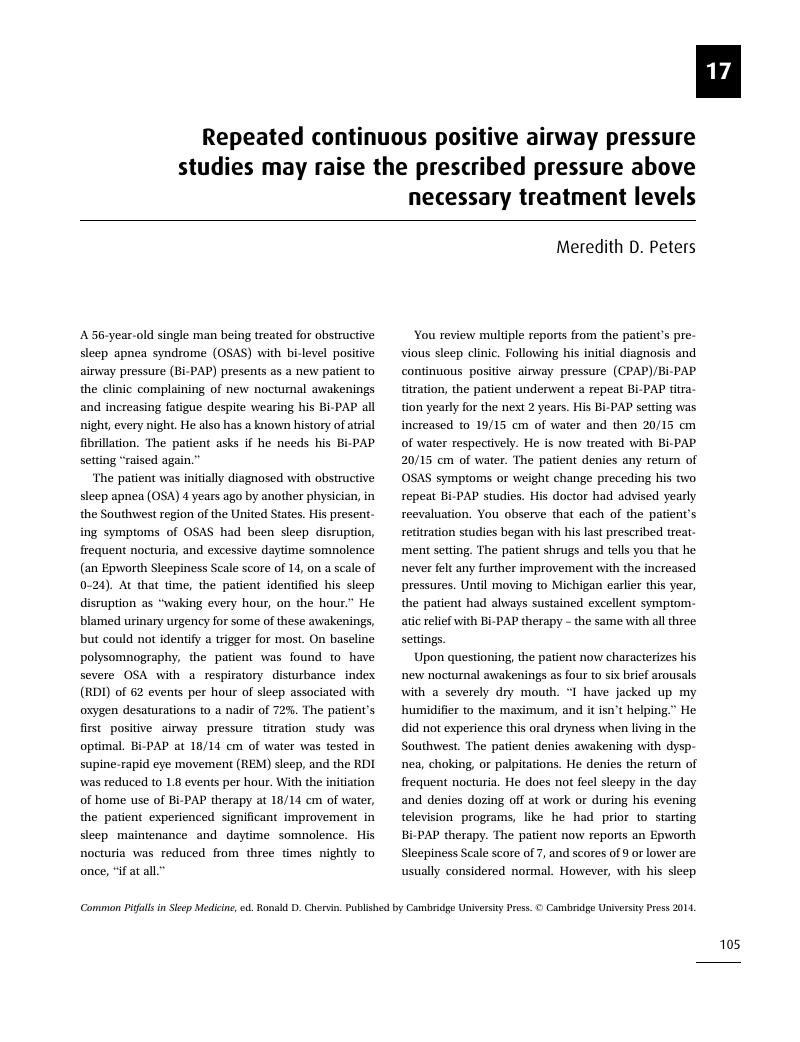Book contents
- Common Pitfalls in Sleep Medicine
- Common Pitfalls in Sleep Medicine
- Copyright page
- Contents
- Contributors
- Preface
- Acknowledgements
- 1 Introduction: the complexity, challenges, and rewards of effective sleep medicine
- Section one Sleepiness versus fatigue, tiredness, and lack of energy
- Section two Assessment of daytime sleepiness
- Section three Diagnosis of narcolepsy
- Section Four Diagnosis of obstructive sleep apnea
- Section Five Positive airway pressure to treat obstructive sleep apnea
- 17 Repeated continuous positive airway pressure studies may raise the prescribed pressure above necessary treatment levels
- 18 Patient education and motivational enhancement can make the difference between adherence and non-use of positive airway pressure
- 19 A daytime “PAP-Nap” can help new patients adjust to the use of continuous positive airway pressure
- 20 Excessive positive airway pressure can create treatment-emergent central sleep apnea (complex sleep apnea)
- 21 Appropriate use of automatically adjusting positive airway pressure can enable a patient to use positive airway pressure therapy
- Section Six Alternatives to positive airway pressure in the treatment of obstructive sleep apnea
- Section Seven Diagnosis and treatment of chronic insomnia
- Section Eight Restless legs syndrome and periodic leg movements
- Section Nine Parasomnias
- Section Ten Circadian rhythm sleep disorders
- Section Eleven Missed diagnoses of obstructive sleep apnea can exacerbate medical and neurologic conditions
- Section Twelve Sleep in children
- Section Thirteen Sleep in older persons
- Index
17 - Repeated continuous positive airway pressure studies may raise the prescribed pressure above necessary treatment levels
from Section Five - Positive airway pressure to treat obstructive sleep apnea
Published online by Cambridge University Press: 05 April 2014
- Common Pitfalls in Sleep Medicine
- Common Pitfalls in Sleep Medicine
- Copyright page
- Contents
- Contributors
- Preface
- Acknowledgements
- 1 Introduction: the complexity, challenges, and rewards of effective sleep medicine
- Section one Sleepiness versus fatigue, tiredness, and lack of energy
- Section two Assessment of daytime sleepiness
- Section three Diagnosis of narcolepsy
- Section Four Diagnosis of obstructive sleep apnea
- Section Five Positive airway pressure to treat obstructive sleep apnea
- 17 Repeated continuous positive airway pressure studies may raise the prescribed pressure above necessary treatment levels
- 18 Patient education and motivational enhancement can make the difference between adherence and non-use of positive airway pressure
- 19 A daytime “PAP-Nap” can help new patients adjust to the use of continuous positive airway pressure
- 20 Excessive positive airway pressure can create treatment-emergent central sleep apnea (complex sleep apnea)
- 21 Appropriate use of automatically adjusting positive airway pressure can enable a patient to use positive airway pressure therapy
- Section Six Alternatives to positive airway pressure in the treatment of obstructive sleep apnea
- Section Seven Diagnosis and treatment of chronic insomnia
- Section Eight Restless legs syndrome and periodic leg movements
- Section Nine Parasomnias
- Section Ten Circadian rhythm sleep disorders
- Section Eleven Missed diagnoses of obstructive sleep apnea can exacerbate medical and neurologic conditions
- Section Twelve Sleep in children
- Section Thirteen Sleep in older persons
- Index
Summary

- Type
- Chapter
- Information
- Common Pitfalls in Sleep MedicineCase-Based Learning, pp. 105 - 110Publisher: Cambridge University PressPrint publication year: 2014

